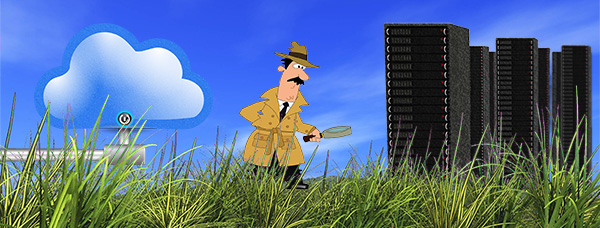In the Cloud or Build Your Own?

“Cloud computing” is everywhere these days, making it seem like anyone not on the cloud bandwagon is in the IT dark ages. The Cloud has moved to the center of the IT world, promising a cheap, easy alternative to building and maintaining an in-house IT infrastructure. But is it always the best solution?
As with a lot of things, it depends.
There are a lots of reasons why running your business on cloud-based applications is a great idea. The barrier to entry is extremely low — with a hosted application, an entire company can be up and running in a matter of minutes. With no server farm to manage, an organization can focus on its core business. If an organization has a need to scale quickly or for brief periods of time, a cloud solution provides the perfect infrastructure to handle the changing load.
At the same time, the cloud can’t be all things to all people, and it has limitations. For those with a static workload, the cloud can be much more expensive than traditional in-house IT. Cloud solutions are tailored toward general IT usage, so custom configurations (for specific performance or network requirements) are not easily achieved. And service outages can and do occur. Cloud solutions that guarantee “four nines” of uptime (99.99%) are prohibitively expensive for many organizations.
Where does the cloud fit best?
IT requirements for any application or service can be measured on a horizontal scale, with Generalized IT at one end and Specialized IT at the other. The cloud is ideal for Generalized IT applications and services like email and file storage. For example, web-based email and scheduling apps, cloud-based CRM, and document storage all work well in the cloud.
On the other end of the spectrum is Specialized IT. Specifically, organizations that run high-performance custom applications, such as a company that requires specialized suites of extremely responsive custom software to manage their inventory, accounting, and web apps. Such an organization would be better served building a computing infrastructure specifically tailored to address their unique needs, rather than “pounding to fit” in the cloud.

Most organizations have applications and services that fall at various places along the spectrum. A hybrid cloud approach gives the most bang for the buck, with a mix of cloud-based services and customized applications on the company’s own servers, either on-site or in their local colo facility.
Case Study – When to build your own infrastructure
One of Pogo’s clients, Kato.im, is a great example of how a startup can benefit by using cloud solutions initially, and transitioning to their own servers as their needs change. Kato has designed a persistent instant messaging platform that revolutionizes the way members of an organization can collaborate. Initially, they relied on a cloud provider to host their messaging application. This worked well at first, allowing them to focus exclusively on developing their product.
However, as Kato’s messaging service began to scale up with more and more users, the limitations of their chosen cloud provider became apparent. There were three main issues that led them to migrate their application to their own servers:
- Persistent Connections – The Kato messaging platform requires persistent open connections, and users often encountered connection resets when the app was hosted in the cloud. The cloud solution could not support “always-on” connections that are a key component of the Kato platform.
- Service Outages – There were several occasions where Kato’s cloud provider unexpectedly went offline for several hours, locking all of their clients out of Kato’s application. Kato had no control of the infrastructure, so they were powerless to get their platform back online.
- Cost – By their own calculations, moving to their own servers is saving them nearly 75% of the price of an equivalent cloud solution.

Getting the Hardware Right
Kato purchased several Pogo Linux Iris 1168 rackmount servers and got them up and running very quickly at their bay area colo facility. They immediately saw the significant benefits of running their own custom servers, both for their budget and for their customers.
Deciding on the best way to apply cloud services to your organization’s needs is seldom a simple equation. With new cloud providers constantly joining the fray and existing players adding new services, it can be challenging to put together the right plan to meet your unique requirements. Despite their ubiquity and low barriers to entry, cloud services are not always the ideal solution. In many cases, companies still benefit most from running their own hardware.
To find out more about how running your own servers stacks up against equivalent cloud solutions, call Pogo at 1 888 828 POGO, or visit us at www.pogolinux.com. Our engineering team is always ready to help you find your best solution.
Pogo Linux Iris 1168 Server
|
|
• Supermicro SYS-1017R-MTF 1U Chassis / 330W • Intel Xeon E5-2600 v3 or v2 series CPU • Up to 256 GB DDR3 1600MHz ECC Registered Memory • 8x 2.5″ SAS Drive Bays (SSD or HDD) • Optional LSI MegaRAID SAS Controller • Slim DVD/ROM • Standard 3-Year Warranty • World-Class Support |
About Kato
Kato is a powerful collaboration platform based on simple chat. Our mission is to help your organization move faster by decreasing email volume and making all communication instantly searchable.” –From the Kato website
If you have any questions about how Pogo can help you solve the issues your organization is facing, please call us at 888-828-POGO, or email .

